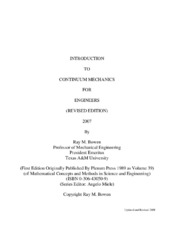| dc.creator | Bowen, Ray M. | |
| dc.date.accessioned | 2005-10-26T02:06:20Z | |
| dc.date.available | 2005-10-26T02:06:20Z | |
| dc.date.issued | 1989 | |
| dc.identifier.citation | Bowen, R. M., 1989, Introduction to Continuum Mechanics for Engineers, Plenum Press, New York, NY. | en |
| dc.identifier.isbn | 0-306-43050-9 | |
| dc.identifier.uri | https://hdl.handle.net/1969.1/2501 | |
| dc.description.abstract | This textbook is intended to introduce engineering graduate students to the essentials of modern Continuum Mechanics. The objective of an introductory course is to establish certain classical continuum models within a modern framework. Engineering students need a firm understanding of classical models such as the linear viscous fluids (Navier-Stokes theory) and infinitesimal elasticity. This understanding should include an appreciation for the status of the classical theories as special cases of general nonlinear continuum models. The relationship of the classical theories to nonlinear models is essential in light of the increasing reliance, by engineering designers and researchers, on prepackaged computer codes. These codes are based upon models which have a specific and limited range of validity. Given the danger associated with the use of these computer codes in circumstances where the model is not valid, engineers have a need for an in depth understanding of continuum mechanics and the continuum models which can be formulated by use of continuum mechanics techniques.
Classical continuum models and others involve a utilization of the balance equations of continuum mechanics, the second law of thermodynamics, the principles of material frameindifference and material symmetry. In addition, they involve linearizations of various types. In this text, an effort is made to explain carefully how the governing principles, linearizations and other approximations combine to yield classical continuum models. A fundamental understanding of these models evolve is most helpful when one attempts to study models which account for a wider array of physical phenomena.
This book is organized in five chapters and two appendices. The first appendix contains virtually all of the mathematical background necessary to understand the text. The second appendix contains specialized results concerning representation theorems. Because many new engineering graduate students experience difficulties with the mathematical level of a modern continuum mechanics course, this text begins with a one dimensional overview. Classroom experience with this material has shown that such an overview is helpful to many students. Of course, more advanced students can proceed directly to the Chapter II. Chapter II is concerned with the kinematics of motion of a general continuum. Chapter III contains a discussion of the governing equations of balance and the entropy inequality for a continuum. The main portion of the text is contained in Chapter IV. This long chapter contains the complete formulation of various general continuum models. These formulations begin with general statements of constitutive equations followed by a systematic examination of these constitutive equations in light of the restrictions implied by the second law of thermodynamics, material frame-indifference and material symmetry. Chapter IV ends with an examination of the formal approximations necessary to specialize to the classical models mentioned above. So as to illustrate further applications of continuum mechanics, the final chapter contains an introductory discussion of materials with internal state variables.
The book is essentially self contained and should be suitable for self study. It contains approximately two hundred and eighty exercises and one hundred and seventy references. The references at the end of each chapter are divided into References and General References. The References are citations which relate directly to the material covered in the proceeding chapter. The General References represent additional reading material which relate in a general way to the material in the chapter.
This text book evolved over an extended period of time. For a number of years, early versions of the manuscript were used at Rice University. I am indebted for the assistance my many students gave me as the lecture notes evolved into a draft manuscript. The final manuscript has been utilized at the University of Kentucky by my colleague, Professor Donald C. Leigh, in an introductory graduate course. I am indebted to him for his many comments and suggestions. | en |
| dc.format.extent | 2498285 bytes | en |
| dc.format.mimetype | application/pdf | |
| dc.language.iso | en_US | |
| dc.publisher | Plenum Press | |
| dc.relation.ispartofseries | Mathematical Concepts and Methods in Science and Engineering | |
| dc.relation.ispartofseries | 39 | |
| dc.subject | Continuum mechanics | en |
| dc.subject.lcsh | Continuum mechanics | en |
| dc.title | Introduction to continuum mechanics for engineers | en |
| dc.type | Book | en |
| local.department | Mechanical Engineering | en |


